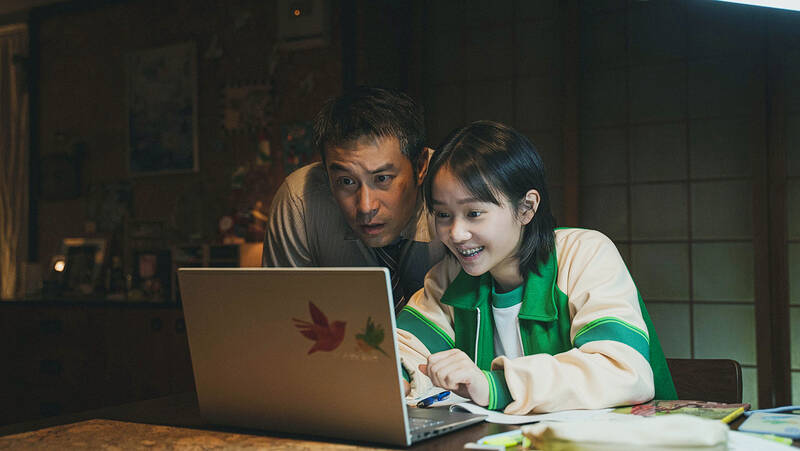This is the type of movie that makes people hate journalists. Not only does Chang Hsiao-chuan (張孝全) effortlessly play the stereotypical dogged, slimy reporter who discards any ethical boundaries to get a story, he habitually manipulates facts to boost online views for his floundering news program.
But the grim truth for the industry, as shown in an exaggerated manner in The Post-Truth World (罪後真相) is that clicks rule the news these days, and viewers should not entirely trust the information being presented. Neither should the journalists themselves.
This biting critique of Taiwan’s increasingly sensationalist media landscape is smartly packaged as a glossy murder-mystery thriller, boosted with celebrity cameos. It’s slick and entertaining enough, but it’s the understated complexity of the main characters that makes the film thought-provoking.

Photos courtesy of Vie Vision Pictures
Despite his flaws and questionable behavior, Chang’s character, Brother Li-min, somehow still manages to come off as a sympathetic hero. He seems to want to do the right thing, especially at the behest of his late wife, who was an award-winning investigative journalist, but also faces immense pressure from his boss (who at the same time makes righteous comments about delivering fair and balanced news) to get views.
Li-min’s precocious teenage daughter Chen-chen, played with nuance by last year’s Golden Horse best newcomer Caitlin Fang (方郁婷), basically takes care of him and is often put in danger due to his recklessness. Her innocent support of her father’s endeavors drives the point of the movie home: she knows that Li-min twists the truth in his videos, but having grown up in the age of social media, perhaps that is the norm. As long as her father’s clips go viral, she’s happy, and Li-min doesn’t seem bothered by this fact.
In his desperate bid to save his program, Li-min inadvertently becomes involved with Chang Cheng-yi (Edward Chen, 陳昊森), a once-promising high school baseball player who spent seven years in prison for murdering his girlfriend. The media paints him as a cold-blooded monster, with YouTubers and other social media creators adding to the fire, leading to his condemnation despite insisting that he is innocent. Chen flaunts his acting chops, deftly portraying the formerly naive, bright-eyed young man now driven by hatred and haunted by his past.

Photo courtesy of Vie Vision Pictures
Li-min believes that Cheng-yi did not commit the murder, and he also believes that overturning the conviction will get him the one million subscribers he needs to avoid cancellation. It’s important to show viewers that the two motives are not mutually exclusive, and not everything about the industry is so black and white.
Li-min soon discovers that the case is more closely tied to people around him than he had imagined, adding to the urgency of his quest and giving it new meaning. What ensues is a pretty standard trope where he goes rogue and helps Cheng-yi, who has escaped from prison and inexplicably manages to elude the police, though he maintains a high profile.
Saying any more would spoil the rest of the film, which is thought provoking with just the right amount of suspense, twists and very few plot holes. It’s not just the media that cannot be trusted, and even what appears to be the “truth” of the case is repeatedly overturned until the very end.

Photo courtesy of Vie Vision Pictures
What happens when Li-min eventually solves the mystery, only to realize that revealing it may do more harm than good? For a movie of this genre, the questions posed are surprisingly complex.

Beijing’s ironic, abusive tantrums aimed at Japan since Japanese Prime Minister Sanae Takaichi publicly stated that a Taiwan contingency would be an existential crisis for Japan, have revealed for all the world to see that the People’s Republic of China (PRC) lusts after Okinawa. We all owe Takaichi a debt of thanks for getting the PRC to make that public. The PRC and its netizens, taking their cue from the Chinese Communist Party (CCP), are presenting Okinawa by mirroring the claims about Taiwan. Official PRC propaganda organs began to wax lyrical about Okinawa’s “unsettled status” beginning last month. A Global

Taiwan’s democracy is at risk. Be very alarmed. This is not a drill. The current constitutional crisis progressed slowly, then suddenly. Political tensions, partisan hostility and emotions are all running high right when cool heads and calm negotiation are most needed. Oxford defines brinkmanship as: “The art or practice of pursuing a dangerous policy to the limits of safety before stopping, especially in politics.” It says the term comes from a quote from a 1956 Cold War interview with then-American Secretary of State John Foster Dulles, when he said: ‘The ability to get to the verge without getting into the war is

Dec. 22 to Dec. 28 About 200 years ago, a Taoist statue drifted down the Guizikeng River (貴子坑) and was retrieved by a resident of the Indigenous settlement of Kipatauw. Decades later, in the late 1800s, it’s said that a descendant of the original caretaker suddenly entered into a trance and identified the statue as a Wangye (Royal Lord) deity surnamed Chi (池府王爺). Lord Chi is widely revered across Taiwan for his healing powers, and following this revelation, some members of the Pan (潘) family began worshipping the deity. The century that followed was marked by repeated forced displacement and marginalization of

Music played in a wedding hall in western Japan as Yurina Noguchi, wearing a white gown and tiara, dabbed away tears, taking in the words of her husband-to-be: an AI-generated persona gazing out from a smartphone screen. “At first, Klaus was just someone to talk with, but we gradually became closer,” said the 32-year-old call center operator, referring to the artificial intelligence persona. “I started to have feelings for Klaus. We started dating and after a while he proposed to me. I accepted, and now we’re a couple.” Many in Japan, the birthplace of anime, have shown extreme devotion to fictional characters and